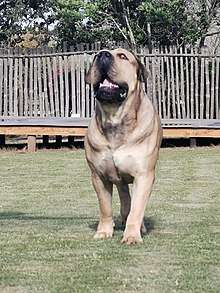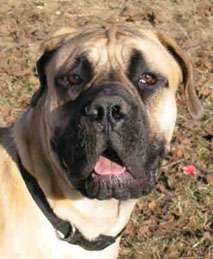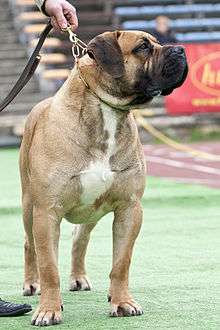Boerboel
The Boerboel [ˈbuːrbul], is a large, mastiff-type dog breed from South Africa[2] that is bred for the purpose of guarding the homestead and working the farm. They are one of the most powerful dog breeds in the world and have an estimated bite force around 800-850 PSI.[3]
| Boerboel | |||||||||||||||||||||||
|---|---|---|---|---|---|---|---|---|---|---|---|---|---|---|---|---|---|---|---|---|---|---|---|
 | |||||||||||||||||||||||
| Origin | South Africa | ||||||||||||||||||||||
| |||||||||||||||||||||||
| |||||||||||||||||||||||
| Dog (domestic dog) | |||||||||||||||||||||||
Boerboel breeding is both a hobby and an industry in South Africa. These dogs are now exported from South Africa to other parts of the world. Due to its use as a farm dog which brought it into conflict with large African predators such as lions, the Boerboel has been artificially selected for ability to protect themselves and others. Individual boerboels have been documented killing Adult male leopards.[4]
Breed history
The word "Boerboel" derives from "boer", Afrikaans/Dutch for farmer, and "boel", old Afrikaans/Dutch for dog.[5] Boerboel, therefore, translates as either "farmer's dog" or "Boer's dog" and should be pronounced somewhat like "boo-er-bool." The Boerboel is the only South African dog breed created to defend the homestead.
Despite the Boerboel's long breeding history, there is great uncertainty as to how many and which breeds were used to create it. It is generally believed that the breed was created from interbreeding native African landrace dogs, such as the Africanis, with breeds brought into South Africa by Dutch, French, and British settlers.
The most likely origins date back to Jan van Riebeeck's arrival to the Cape in 1652, who brought with him a "Bullenbijter", which is Dutch slang for Bulldog.[6] Other original and later European settlers brought large, strong dogs that almost certainly bred with the indigenous domestic dog breeds of South Africa.[1][7]
In the early 1860s, when military posts were scattered across the South African frontier, bloodhounds, staghounds, greyhounds, bulldogs, terriers, mastiffs, pointers, and occasionally foxhounds were to be found at each post. The Boer dog was a cross between these breeds. It was generally in the vicinity of military posts where the best Boer dogs were to be found. In addition, the best dogs for hunting leopards and baboons were a cross between a mastiff and a bulldog.[8]
Later, in 1928, the diamond mining company De Beers imported Bullmastiffs to South Africa to guard the mines. This breed was also crossbred with Boerboels in the region.[6]
Modern Boerboels
The Boerboel was first introduced to purebred enthusiasts throughout the world, including the United States, by the American anthropologist Dr. Carl Semencic, first in an article in Dog World Magazine and later in his book entitled Gladiator Dogs which was first published by T.F.H. Publications in 1998 and later republished by another publisher in 2013. Semencic credits his early familiarity with the breed to his own travels to South Africa, but especially to his frequent correspondence with the head of the first South African Boerboel club, one Mr. Kobus Rust. Later, the Boerboel Breeders Association was established in 1983 in the Senekal district of the Free State with the sole objective of ennobling and promoting the Boerboel as a unique South African dog breed.
Description
Appearance

The Boerboel is a large dog, with a strong bone structure and well developed muscles. The head appears blocky, but not overdone, with a short length between the stop and nose. It should look impressive, carrying himself with confidence and powerful movement, which should be buoyant, and unencumbered, despite its size. It should be symmetrical and balanced, following the desired proportions for the breed. Males should be markedly bigger than females, there is a distinct sexual dimorphism, with the female less prominently developed physically. [9]
There is also a divergence of standards. The Kennel Union of South Africa does not accept the black coat[10] but SABBS does, so a buyer needs to decide what standard to follow, as a dog that has a black coat, or is the descendant of a dog with a black coat, cannot be registered with AKC, UKC or BI.
Coat
The Boerboel is a below average shedder and easy to groom. The occasional brushing and a monthly bath and nail trim is all that is needed. The breed has an outer coat that is normally coarse and straight, and an undercoat that is soft and dense.[11]
Its coat is short and sleek with dense hair coverage. The recognised colours are brindle, fawn, brown and Black.[2] Many dogs have a black mask around their mouth that sometimes extends to their eyes and ears.
Temperament

Boerboels are an intelligent and energetic breed.[7] They are loyal, great with children, and tend to be protective of their family and territory.[11][12]
They are quite charming when not being lazy, and will not hesitate to defend their loved ones to the death.[7]
They are often called "Velcro" dogs, always wanting to be with their owners, and so, are not prone to wandering off on their own.
The Boerboel also requires training and firm handling from an early age. [9] It is not unusual for this breed to display aggression toward other dogs or strangers.[13]
The protective character of the Boerboel is still evident and is much sought after, as is the calm, stable, and confident composure of the breed. The dogs are obedient and intelligent and have strong territorial instincts. The Boerboel remains the guarding breed of choice amongst current day farmers and is very popular for the same reason in urban communities.[14]
Health
Boerboels are generally known for their good health. However, Boerboels can suffer from hip[15] or elbow dysplasia, vaginal hyperplasia,[16] ectropion, and entropion.[1][12] Recently, juvenile epilepsy (with attacks brought on by metabolic changes or stress) has appeared in the boerboel breed.[17] A boerboel's behavior and comportment may change over time.[18] The average life expectancy is ten to twelve years.[19]
Temperament
A Boerboel requires a significant commitment in time and energy as they need to be trained and properly socialized in order to be happy, well-adjusted family members.[1][11][12]
These dogs thrive under positive reinforcement training techniques and require human companionship and structure. If left isolated, Boerboels will digress and may become destructive. Forcefully controlling the dog is detrimental to their psychological health and could cause potential behavioral backlash in the future. These dogs benefit from an owner who respects their size and strength but is not fearful of it.
Although more suited to large yards, Boerboels are adaptable as long as they receive regular exercise and a lot of attention but can struggle with living in small environments. Whatever the amount of space available, they need to have plenty of physical and mental exercise.[1] The Boerboel can be exercised in a large, securely enclosed yard, but at a minimum this type of dog needs to be taken on a long walk every day. According to the SABBS it is the owner's responsibility to keep the dog safe, properly controlled and supervised in public, or when around children or people it is not familiar with. It is also important to note that the boerboel was bred to tackle large animals like lions and baboons, so strict training should be incorporated to avoid aggression [20]
Restrictions
In 2002, Romania prohibited the import of the Boerboel, and restricted ownership to those with a court order allowing them to own the dog.[21]
In 2010, the Boerboel was banned in Denmark.[22]
In 2011, Russia designated the Boerboel an "especially dangerous breed," subject to mandatory registration and certification.[23]
Ukraine has classified the Boerboel as a dangerous dog, subject to mandatory microchipping, muzzle, and civil liability insurance.[24]
The Boerboel is also banned or prohibited in:
- France[25]
- Fairfield, Iowa[26]
- Malaysia[27]
- Qatar[28]
- Geneva, Switzerland[29]
- Mauritius[30]
- Bermuda[31]
Importation of the Boerboel is illegal/banned in:
- Singapore—currently existing dogs must have insurance in the amount of not less than $100,000, sterilization, microchipping, and muzzle.[32]
- Denmark—currently existing dogs must be muzzled and leashed at all times in public.
- Romania—owners must be at least 18 years of age, and be certified psychologically fit to own a dog of this breed.
- Tunisia [33]
- Faroe Islands [34]
- Turks and Caicos[35]
See also
- South African Boerboel Breeders' Society[36]
- Animal Socialization
- Boerboel International
- Fédération Cynologique Internationale
- Guard dog
- Obedience training
- History of South Africa – Colonization (1652–1815)
References
- Breed description, UK Boerboel Club, archived from the original on 17 April 2012, retrieved 6 September 2014
- "SABBS - Breed Standard".
- Ellis, Jennifer Lynn; Thomason, Jeffrey; Kebreab, Ermias; Zubair, Kasim; France, James (2009). "Cranial dimensions and forces of biting in the domestic dog". Journal of Anatomy. 214 (3): 362–373. doi:10.1111/j.1469-7580.2008.01042.x. PMC 2673787. PMID 19245503.
- Standard Encyclopaedia of Southern Africa, Capetown. South Africa, n.p, 1971. |page 57
- "Boerboel Dog: What You Should Know About South African Boerboels – All Things Dogs". Retrieved 24 February 2020.
- "Breed standard (Appendix A)" (PDF). Sabt.co.za. Archived from the original (PDF) on 16 August 2012. Retrieved 18 September 2012.
- "Know the Boerboel sabt.co.za" (PDF). Archived from the original (PDF) on 6 March 2012. Retrieved 18 September 2012.
- A South African (February 1909). "The Boer Hunting Dog". Agricultural Journal of the Cape of Good Hope. 34 (2): 186–188. hdl:10520/AJA0000018_1086.
- Boerboel, Kennel Union of South Africa, archived from the original on 14 August 2014, retrieved 6 September 2014
- Boerboel, Kennel Union of South Africa, archived from the original on 14 August 2014, retrieved 6 September 2014
- "Boerboel Dog & Puppies Boerboel – Dog of the Boers". Dog-names.org.uk. Retrieved 18 September 2012.
- "Buying a Boerboel sabt.co.za 10 March 2009" (PDF). Archived from the original (PDF) on 1 October 2011. Retrieved 18 September 2012.
- "Breed standard" (PDF).
- "Preamble of Official Breed Standard of Boerboel International Boerboel International Breed Standard". Boerboelinternational.eu. Archived from the original on 1 August 2012. Retrieved 18 September 2012.
- "New Hip Dysplasia Grading System sabt.co.za 3 June 2007" (PDF). Archived from the original (PDF) on 1 October 2011. Retrieved 18 September 2012.
- "Vaginal hyperplasia sabt.co.za 12 July 2007" (PDF). Archived from the original (PDF) on 1 October 2011. Retrieved 18 September 2012.
- Stassen, Quirine E. M.; Grinwis, Guy C. M.; van Rhijn, Nieke C.; Beukers, Martjin; Verhoeven‐Duif, Nanda M.; Leegwater, Peter A. J. (2019). "Focal epilepsy with fear‐related behavior as primary presentation in Boerboel dogs". Journal of Veterinary Internal Medicine. 33 (2): 694–700. doi:10.1111/jvim.15346. PMC 6430876. PMID 30580458.
- Wade, John (29 May 2010). "High-end lifetime training is mandatory". Sarnia Observer. Archived from the original on 14 April 2016. Retrieved 2 April 2016.
- Lynne Berridge (2004). "Accolade Boerboels". Boerboels.co.uk. Retrieved 18 September 2012.
- "SABBS - Buying a Boerboel".
- "List of Banned Dogs by Countries". petolog.com. Retrieved 28 July 2015.
- Ritzau /Nyheder, Mette Pedersen (19 January 2011). "Ekstra Bladet - 13 kamphunde forbydes". Ekstrabladet.dk. Retrieved 18 September 2012.
- "List of Banned Dogs by Countries".
- "List of Banned Dogs by Countries". petolog.com. Retrieved 3 August 2015.
- "Pet Breeds unable to travel in Europe". www.viajedemascotas.com. Retrieved 3 August 2015.
- "U.S. List of Banned Breeds". www.terrificpets.com. Retrieved 3 August 2015.
- Moore, Caitlin. "Moving Pets to Malaysia: Importing Pets to Sabah and Sarawak | PetRelocation.com". Retrieved 3 August 2015.
- "Importing a cat or dog - Doha Family - Autumn 2014". www.dohafamily.com. Retrieved 3 August 2015.
- "Banned Dog Breeds in Switzerland - Documents". Retrieved 3 August 2015.
- "Mauritius Pet Passport - Current Dog and Cat Import Requirements". www.pettravel.com. Retrieved 3 August 2015.
- "Banned, restricted dogs breed reminder | The Royal Gazette:Bermuda News". Retrieved 3 August 2015.
- "List of Banned Dogs by Countries". petolog.com. Retrieved 3 August 2015.
- "IATA - Tunisia Customs, Currency & Airport Tax regulations details". www.iatatravelcentre.com. Retrieved 3 August 2015.
- "It is prohibited to import the following dogbreeds to the Faroe Islands" (PDF). Archived from the original (PDF) on 24 September 2015.
- "Turks Caicos Pet Passport - Current Dog and Cat Import Requirements". www.pettravel.com. Retrieved 3 August 2015.
- "SABBS - Home".